
Purified water systems are present across biotech, pharmaceutical, chemical, and other industrial applications where water treatment is needed. The purification process frees the water from contaminants like chemical compounds and organic/inorganic substances. Consequently, most of these systems use corrosion-resistant materials, with stainless steel often preferred for its additional advantage of withstanding higher temperature and pressure.
Installation of these purified water systems can be challenging, though. The slightest change in properties of the material during processes such as welding can affect purification. By adopting an effective welding process such as orbital welding in purified water systems, the installation and maintenance processes can be performed reliably.
What Material Is Suitable To Use in Purifying Systems?
When considering materials for purified water systems, ensuring the purity and safety of the purified water are paramount. As a result, many systems available in the market have employed plastics because of advantages that include:
- Corrosion resistance
- Smooth surface finish
- Simple installation
However, more systems are exploring and adopting stainless steel instead of plastics for the added benefits.
Benefits of Stainless Steel in Purifying Systems
- High pressure and temperature resistance: Purification systems often require monitoring for over-pressurization and unfavorable temperature. At ambient temperature, the system components can be susceptible to organic/inorganic contamination. And to prevent the formation of biofilms capable of contaminating the system, a higher flow rate is required. The mechanical strength of stainless steel means it can handle the resulting higher pressure and temperature in the system.
- Sanitation: Stainless steel provides a smooth surface finish. When installed properly, stainless steel also minimizes opportunities for bacteria growth and contamination. Additionally, compared to materials like plastic, stainless steel is also much easier to clean without the risk of abrasion.
- Operating cost: While plastics may be the cheaper choice of material, stainless steel provides a longer operational life. Compared to other materials, stainless steel has a lower cost of ownership.
Installation and Maintenance With Orbital Welding
When considering stainless steel in purified water systems, be sure to consider the critical installation and maintenance procedures that welding requires. Given the characteristics of stainless steel, it’s important to ensure proper weld parameters to avoid the potential detrimental effects.
- Contamination resulting from improper welds is a major concern when welding purified water systems. To overcome this issue, let established standards and specifications guide your sanitary welding practices. Emphasis should be placed on selecting an ideal welding process, such as TIG (Tungsten Inert Gas) welding, where proper heat input control can enable high-quality weld results.
- When welding material such as austenitic stainless steel, chromium can deplete from the grain boundaries and reduce corrosion-resistant properties. Defects such as stress corrosion cracking can result. With proper weld prep and accurate welding process selection, operators can attain adequate penetration and proper shielding to help maintain corrosion resistance in the heat-affected zone.
- Hexavalent chromium and similar hazardous fumes present stainless steel welding health and safety risks. Selecting an automated welding system can protect welders from exposure to these harmful substances and the resulting long-term health effects.
A mechanized welding process like orbital welding in purified water systems can address these concerns. The automation supported with auto weld heads and remote monitoring facilitates control and optimization of weld parameters—including heat input and feed rate—to ensure a precise weld output. This feature also helps minimize risk for welders by reducing their exposure to harsh fumes and enabling welding in hard-to-reach areas. Adaptation of processes such as orbital TIG also provides excellent shielding of weld areas, reducing the exposure to external inclusions. As a result, corrosion-resistant properties of the metal remain intact and can ensure sanitation in the purified water systems.
Ensuring Precision With Orbital Welding in Purified Water Systems
As purified water systems require clean operation and the consideration of high temperature and pressure, selecting an appropriate material and welding process is a must. Stainless steel and an orbital welding process provides an ideal combination for effectively installing and maintaining the purification system. With orbital welding in purified water systems, manufacturers can discover cost-effective solutions across many industries.
Arc Machines, Inc. provides a range of orbital welding technologies, including auto weld heads and remote weld pendants that support efficient welding of stainless steels to meet sanitary standards. For product inquiries and to discuss any further questions regarding orbital welding in purified water systems, contact sales@arcmachines.com. To develop a custom solution, contact us to arrange a meeting.




